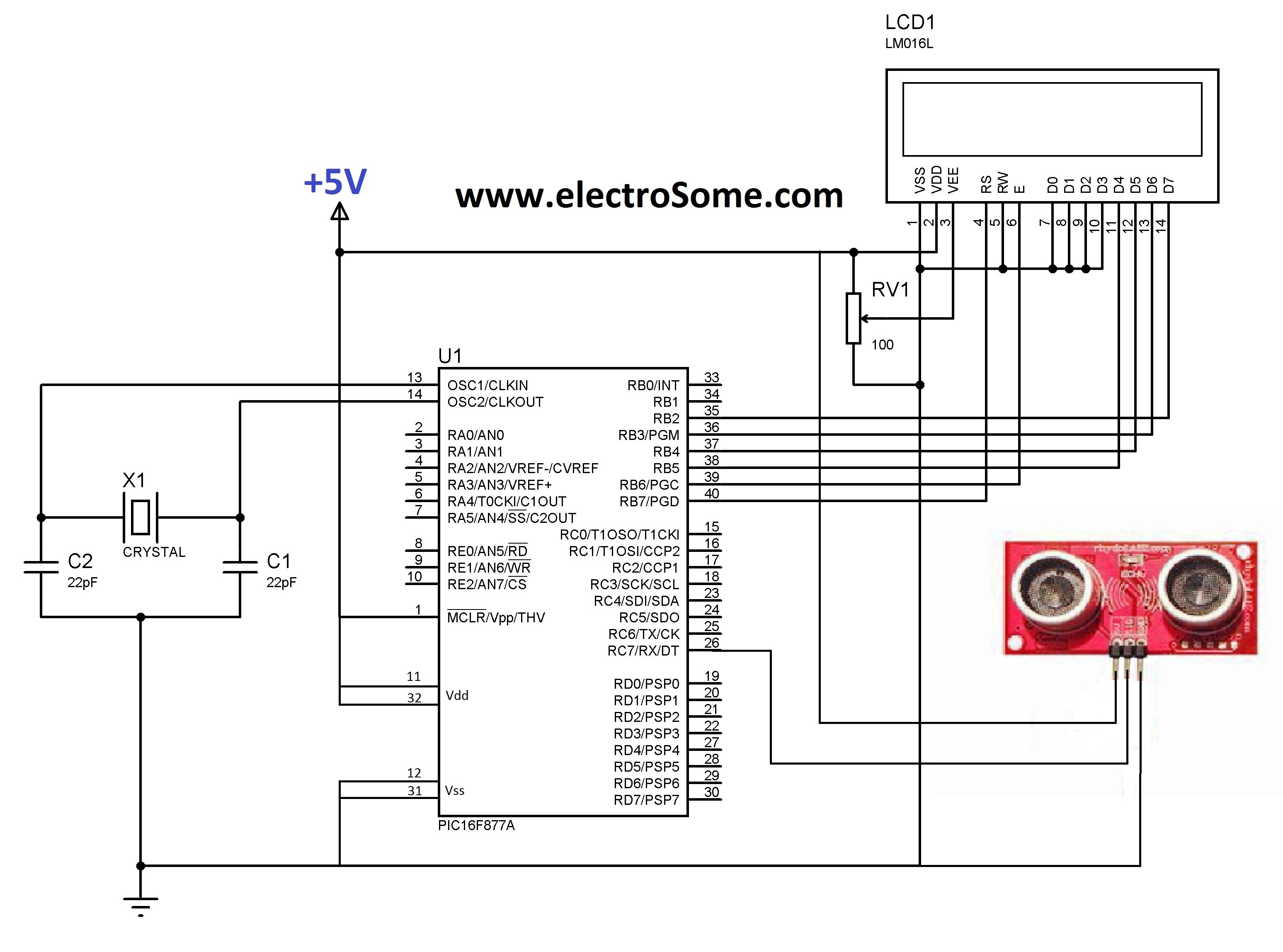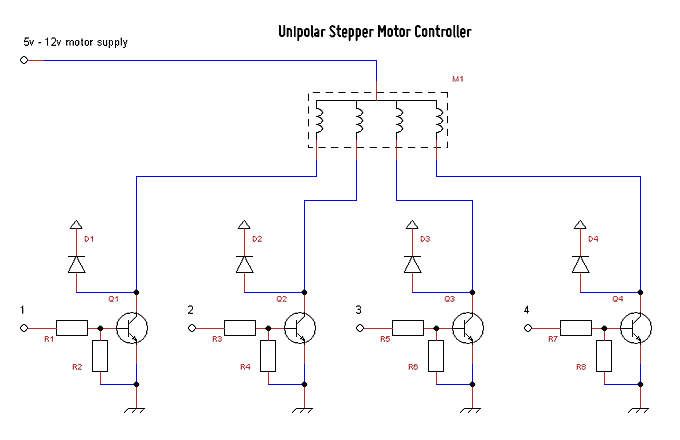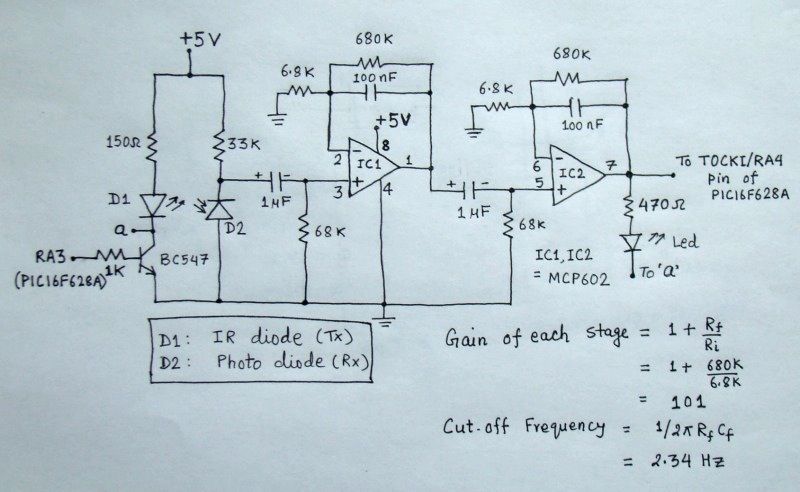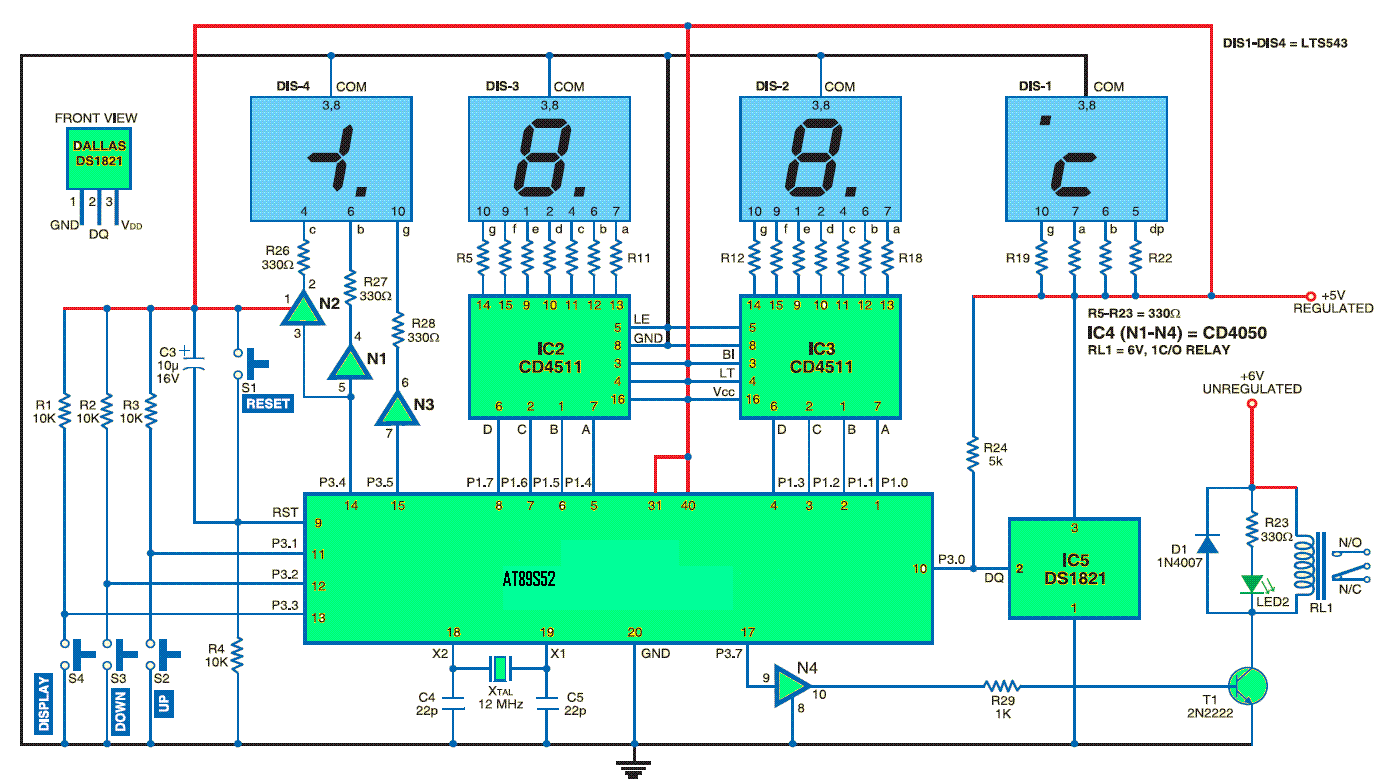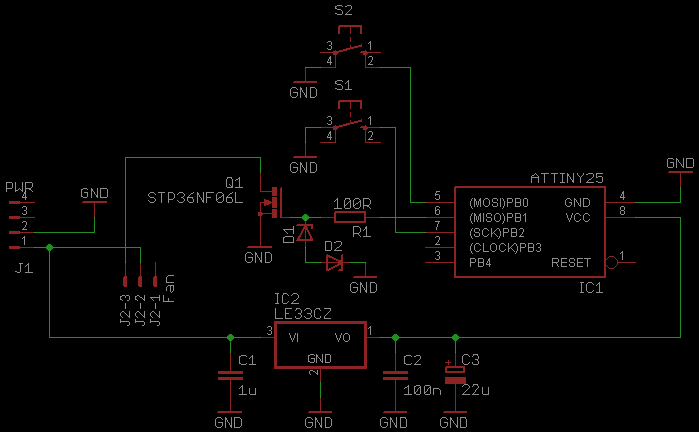
Strobo controller
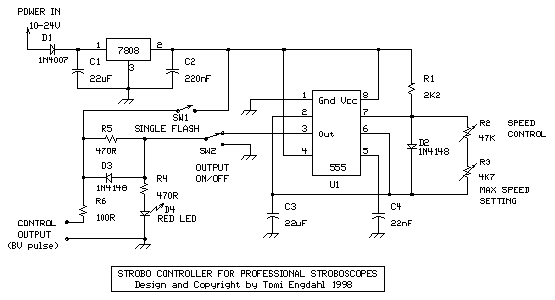
Most stroboscopes designed for commercial use, such as light effects, theatrical lighting, and DJ lights, are equipped with external trigger connectors on the back. These trigger inputs typically utilize 6.3 mm jacks or XLR connectors. Occasionally, there is one input and one output jack, allowing multiple stroboscopes to be easily connected to a single controller. This can be achieved by connecting the first stroboscope to the controller and wiring the subsequent stroboscopes to the output of the first unit. The stroboscope controller functions as a simple adjustable multivibrator, capable of generating frequencies within the range of 1 to 15 Hz, providing suitable control signal pulses to trigger the stroboscope. The circuit diagram is a modified standard 555-based astable oscillator circuit, enhanced with additional electronics on the output side. The capacitor C3 charges through R1 and D2. When the capacitor reaches full charge, the 555 timer outputs a high stage (+8V output voltage). The timer then discharges the capacitor through R2 and R3, where the resistance values of R2 and R3 determine the discharge time and consequently the pulse frequency, typically between 1 and 15 Hz. The output of the 555 timer can be connected to the output circuitry using SW2. The output circuitry includes an LED (D4) that indicates the signal output state with flashing pulses. Normally, positive pulses reach the output connector through D3 and R6. A single manual flash can be activated by pressing SW1, which connects the circuit power to the output pin (also R6). R6 limits the current to safe levels to prevent damage in the event of a short circuit in the control cable or connectors. The circuit is powered by a 7808 regulator with capacitors C1 and C2, which provide a stable 8V output from the input voltage. D1 protects the circuit from incorrect polarity input voltage. Component specifications include: C1 - 22 µF 35V electrolytic, C2 - 220 nF, C3 - 22 µF, C4 - 22 nF, D1 - 1N4007, D2 and D3 - 1N4148, D4 - high-intensity red LED, R1 - 2.2 kΩ, R2 - 47 kΩ potentiometer (linear), R3 - 4.7 kΩ trimmer, R4 - 470 Ω, R5 - 470 Ω, R6 - 100 Ω 1W, SW1 - pushbutton (momentary), SW2 - changeover switch, U1 - LM555 or NE555 timer, U2 - 7808 voltage regulator IC. Given that the strobe controller will encounter various mechanical shocks during operation, it is advisable to construct it with robust mechanical protection. A high-quality project case should be used to safeguard the circuit and ensure that the circuit board is mounted securely to withstand impacts, such as being dropped from a table. In certain applications, a heavy metal enclosure with rubber feet may provide additional stability, preventing the unit from tipping over due to the weight of the strobe control cable. It is essential to use a durable potentiometer and install a sturdy knob to prevent damage from mechanical shocks. Additionally, the switches and buttons should be of high quality to withstand frequent use, as inferior components may fail unexpectedly. The 7808 regulator does not require a heatsink, as the current draw of this circuit is minimal. The circuit can be assembled on a compact circuit board or a small piece of veroboard. A reliable connector for the power input is crucial, given the expected heavy usage. A 6.3 mm jack should be utilized for the signal output, as this connector is robust and commonly used in similar applications, allowing for standard audio cables to be employed between the controller and the stroboscope. Once the circuit is assembled and operational, the maximum frequency limit must be configured.Most of the strobocopes designed for commercial use (light effects, theatrical lighting, DJ-lights) have a external trigger connectors on the back of the strobocope. Those connectors trigger input are typically 6. 3 mm jacks or XLR connectors. Sometimes there is one input and one output jacks so that many stroboscopes can be easily wired to one controler
by just connecting the first stroboscope to controller and wiring next strobocope to the output of he first stroboscope etc. This stroboscope controller is a simle adjustable multivibrator which gan easily generate frequencies at frequency range 1.
15 Hz and output suitable control signal pulse to trigger the stroboscope. The circuit diagram is a little bit modified standard 555 based astable oscillator circuit with some extra electronics added to the output side. The capacitor C3 is charged through R1 and D2. When capacitor charges the 555 timer outputs high stage (+8V output voltage). When the capacitor is fully charged the 555 timer starts to discarge it through R2 and R3. The resistance of R2 and R3 ddetermines the discharge time (and so the frequency of pulses, typically between 1 and 15 Hz).
The output of the 555 timer can be connected to the output circuitry using SW2. The output circuitry has a LED D4 which shows the signal output state (flashing pulses). Normally the positive pulses get to the output connector through D3 and R6. Single manual flash can be accomplished by pressing SW1 which connects the circuit power to the output pin (also R6). R6 is on the output to limit the current to safe values in situation where there is a short circuit in the control cable or in the connectors.
to 7808 regulator with C1 and C2 make a well regulated 8V voltage from the input voltage. D1 is in the power input to protect this circuit against wrong polarity input voltage. C1 22 uF 35V electrolytic C2 220 nF C3 22 uF C4 22 nF D1 1N4007 D2, D3 1N4148 D4 RED LED (high intensity model preferred) R1 2. 2 kohm R2 47 kohm potentiometer (lin) R3 4. 7 kohm trimmer R4 470 ohm R5 470 ohm R6 100 ohm 1W SW1 Pushbutton (push turns it on) SW2 Changeover switch U1 LM555, NE555 or similar U2 7808 regulator IC Because the strobo controller is expected to face all kind of mechahical shocks in it`s operating environment it is recommended to construct it mechanically well.
Use a good quality project case which protects the circuit nicely and where you can fit the circuit board so that it can take mechanical shocks without damage (for example stand dropping from a table). In some apllications a quite heavy metal box with rubber feets might be a very good because it does not drop easily from the table because of the weight of the strobo control cable.
Use a good quality potentiometer and install a good knob carefully so that mechanical shock to the knob can`t easily damage the potentiometer. Use switch and button which can take hard use without damage. Cheap buttons can break up easily which is not very nice when you need the strobo controller. Better to be safe than sorry. The 7808 regulator does not need a heatsink because the current taken by this circuit is quite small.
There circuit itself can be constructed to a small circuit board (you have to design your own) or to a small piece of veroboard. Use a good quality connector for the power input because your circuit is expected to take hard use. Use 6. 3 mm jack for the signal output, because this connector can take some hard use and it is widely used in this kind of applications.
When you use stadard connector you can also use standard audio cables between the controller and the stroboscope. I built my own circuit to a small plastic box where I fitted the DC power connector, 6. 3 mm output jack, switches and potentionmeter. The picture below is as taken from my protoype: When you have the circuit ready and working then you have to set up the maximum frequency limit on this circuit.
It is 🔗 External reference
by just connecting the first stroboscope to controller and wiring next strobocope to the output of he first stroboscope etc. This stroboscope controller is a simle adjustable multivibrator which gan easily generate frequencies at frequency range 1.
15 Hz and output suitable control signal pulse to trigger the stroboscope. The circuit diagram is a little bit modified standard 555 based astable oscillator circuit with some extra electronics added to the output side. The capacitor C3 is charged through R1 and D2. When capacitor charges the 555 timer outputs high stage (+8V output voltage). When the capacitor is fully charged the 555 timer starts to discarge it through R2 and R3. The resistance of R2 and R3 ddetermines the discharge time (and so the frequency of pulses, typically between 1 and 15 Hz).
The output of the 555 timer can be connected to the output circuitry using SW2. The output circuitry has a LED D4 which shows the signal output state (flashing pulses). Normally the positive pulses get to the output connector through D3 and R6. Single manual flash can be accomplished by pressing SW1 which connects the circuit power to the output pin (also R6). R6 is on the output to limit the current to safe values in situation where there is a short circuit in the control cable or in the connectors.
to 7808 regulator with C1 and C2 make a well regulated 8V voltage from the input voltage. D1 is in the power input to protect this circuit against wrong polarity input voltage. C1 22 uF 35V electrolytic C2 220 nF C3 22 uF C4 22 nF D1 1N4007 D2, D3 1N4148 D4 RED LED (high intensity model preferred) R1 2. 2 kohm R2 47 kohm potentiometer (lin) R3 4. 7 kohm trimmer R4 470 ohm R5 470 ohm R6 100 ohm 1W SW1 Pushbutton (push turns it on) SW2 Changeover switch U1 LM555, NE555 or similar U2 7808 regulator IC Because the strobo controller is expected to face all kind of mechahical shocks in it`s operating environment it is recommended to construct it mechanically well.
Use a good quality project case which protects the circuit nicely and where you can fit the circuit board so that it can take mechanical shocks without damage (for example stand dropping from a table). In some apllications a quite heavy metal box with rubber feets might be a very good because it does not drop easily from the table because of the weight of the strobo control cable.
Use a good quality potentiometer and install a good knob carefully so that mechanical shock to the knob can`t easily damage the potentiometer. Use switch and button which can take hard use without damage. Cheap buttons can break up easily which is not very nice when you need the strobo controller. Better to be safe than sorry. The 7808 regulator does not need a heatsink because the current taken by this circuit is quite small.
There circuit itself can be constructed to a small circuit board (you have to design your own) or to a small piece of veroboard. Use a good quality connector for the power input because your circuit is expected to take hard use. Use 6. 3 mm jack for the signal output, because this connector can take some hard use and it is widely used in this kind of applications.
When you use stadard connector you can also use standard audio cables between the controller and the stroboscope. I built my own circuit to a small plastic box where I fitted the DC power connector, 6. 3 mm output jack, switches and potentionmeter. The picture below is as taken from my protoype: When you have the circuit ready and working then you have to set up the maximum frequency limit on this circuit.
It is 🔗 External reference
Warning: include(partials/cookie-banner.php): Failed to open stream: Permission denied in /var/www/html/nextgr/view-circuit.php on line 713
Warning: include(): Failed opening 'partials/cookie-banner.php' for inclusion (include_path='.:/usr/share/php') in /var/www/html/nextgr/view-circuit.php on line 713
